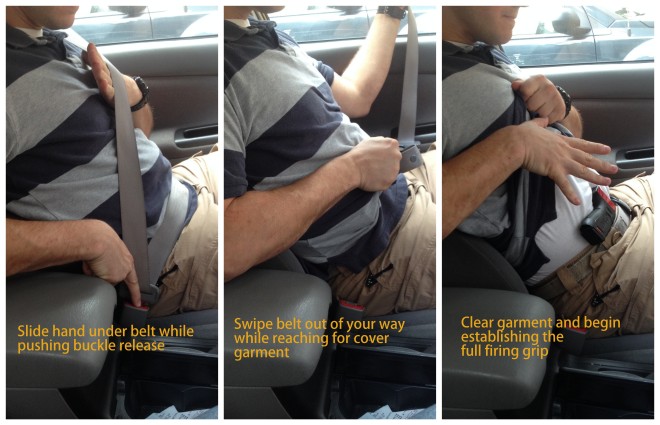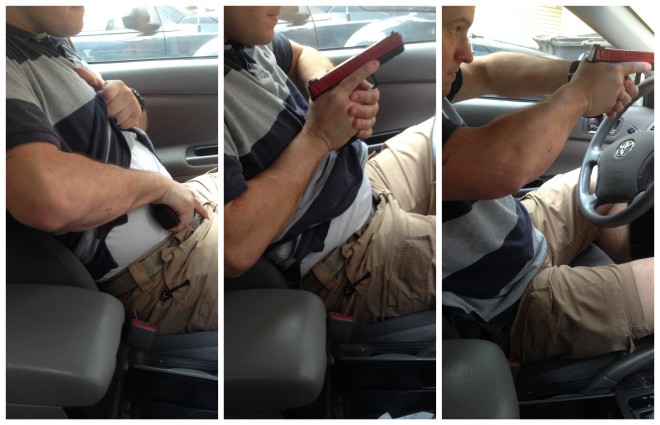Our 2,000 pound bullet (car) has failed us. We didn’t have the car on, we weren’t in drive, or we find ourselves in a circumstance that otherwise prevents our escape. To make it more dire, we have our little one with us. We have no other option but to ‘skin our smoke wagon’ and fight.
The Mission: Safely deploy our pistol from the buckled and seated position and allow ourselves to escape the car quickly and without being entangled with the car.
Here’s some relevant things to know about shooting in a car:
- It’s loud. Like, way louder than you’re expecting. You’ll probably be sorry that you had to shoot from inside the car.
- Going from inside the car through the windshield, bullets will tend to deflect upward. Depending on the weight of your bullets, as much as 3 inches at 7 yards or so. Google around and you can find some test data through windshields.
- The trick to getting good hits through glass is to start shooting at a target, and keep shooting through the same hole. You make your own tunnel through the glass.
- The 4 firearms safety rules still apply. You can usually get away with breaking one rule at a time, but any more than that can get you into trouble quickly. Like James Yeager says, “shooting yourself in a gunfight still counts”.
- Cars are bullet magnets. If I have the little one with me, I will be leaving the car as quickly as possible to keep the heat away from the kid. We have to have the means to get out quickly and without injuring ourselves.
- It might not be the best TACTIC to start a slug-fest gun fight at 2 feet. Everyone loses at these ranges. You may have to feign compliance or wait for your chance. Know your capabilities and limitations. The Way to learn this is through honest self evaluation and training.
- Take the time to unbuckle your seat belt. There is nothing more unbecoming than being caught in your seat belt during a gunfight.

The Draw-stroke:
- To clear the seat belt do a similar movement as you would do if you were just drawing your gun. Slide your left hand under the strap by your shoulder while your buckle hand disengages the latch. Use the hand under the strap to swipe the belt away. You now have access to your gun and can freely leave the car.

- Repeat the general motions from step one to get your gun into play. Reach down and rip the cover garment away with one or both hands and hold it clear with the left hand. Establish grip with the right. Begin your draw-stroke. There are distinct advantages to drawing from the appendix (1 o’clock) position from inside a car. The direct line from holster to targets is helpful.

- The 4 o’clock draw is similar. You can either pull yourself forward on the steering wheel (which I did in the photos), or you can use your right foot to stomp on the floorboard to lighten your gun side and pivot your hips to make space to access the gun. Keep your muzzle discipline extra strict and your draw-stroke compact. There are lots of objects and no-shoots that you can easily cover with the muzzle during this process.

- Pivot directions in the car. You’ll notice you’re shooting in non-ideal and contorted shooting positions. To your left you’ll be in an almost Center Axis Relock position. Straight ahead and you’ll be in a compressed extension. To the right you might end up in a one handed shooting situation. Just remember ‘Sights and Trigger’ and don’t sweat the details.

- When it’s time to leave, just stay compact with your gun and keep your muzzle averted. Post your foot on the door as it opens and use your leg to post and prevent it from bouncing back against your shins.

In future posts, I’ll share some ways I practice this in the comfort of my own home during dry fire. I’ll also share some ways you can practice this at a range even if you don’t have a car you can shoot through.
This isn’t the only way, it’s just a way. Keep that in mind and think through it for yourself.
Once again, I owe a lot of this info to all of the great instructors I’ve had the chance to train with. The vehicle tidbits come primarily from Craig Douglas of http://shivworks.com/ and James Yeager of http://www.tacticalresponse.com/.






